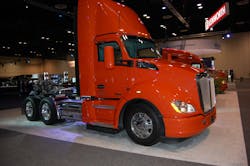MT. VERNON, WA. As truck orders reach new record heights, manufacturers such as Kenworth Truck Co. are starting to see a shift in the types of models selected by motor carriers – with more of them adding daycabs to their fleet mix.
At a macro level, the impact of e-commerce is currently sparking a higher percentage of daycab orders than in the past,” said Stephan Olsen, Kenworth’s director of product planning, during an interview here at a test drive event held at the PACCAR Technical Center.
The event provided editors with a chance to get behind the wheel of the company’s $7 million prototype Zero Emission Cargo Transporter (ZCET) a hybrid T680 daycab modified to run on electricity provided by both a lithium-ion battery back and hydrogen-powered fuel cell.
Olsen explained that changes in distribution patterns being spurred by the “just-in-time” or “JIT” demands of e-commerce is leading fleets to order more daycab tractors than before, though he stressed that “this is certainly not the end” of demand for long-haul highway sleeper tractors.
“We don’t see that long-haul coast-to-coast market going away,” Olsen noted.
The other influence he sees driving demand for more daycab tractors is the desire for more home time by the incoming generation of drivers.
“Fleets are trying to leverage the daycab model as a way to attract more new entrants into the driver profession,” Olsen said. “On the driver side, more and more of them want more home time.”
In terms of powertrain spec’ing, however, he does not see the “sleeper versus daycab” decision changing altering engine displacement selection all that much.
Olsen does think there will be more demand for automated transmissions and does think deployment of daycabs into more regional and short-haul applications will lower average speeds over a truck’s life cycle and requiring different gearing parameters.
“But regardless of whether the fleet wants daycabs or sleepers, the focus remains on fuel economy,” Olsen said. “They will choose packages that deliver the best fuel economy possible.”
About the Author
Sean Kilcarr
Editor in Chief
Sean Kilcarr is a former longtime FleetOwner senior editor who wrote for the publication from 2000 to 2018. He served as editor-in-chief from 2017 to 2018.
